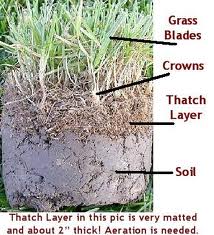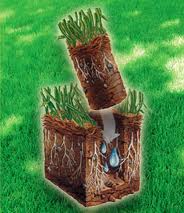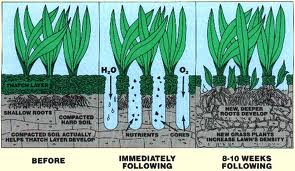Thatch buildup can be harmful to your lawn!
The thatch layer is a normal part of any lawn. It consists of both living and dead organic materials, including the surface roots, stems and crowns of dead grass plants. Located on top of the soil and underneath your grass plants, thatch can become a problem if too much is allowed to accumulate.
 When the thatch layer gets to be more than ½” thick, it can prevent air, water and nutrients from reaching you lawn’s root system. Plus, it can become a home for various types of insects and fungus diseases that can damage and even kill your turf.
When the thatch layer gets to be more than ½” thick, it can prevent air, water and nutrients from reaching you lawn’s root system. Plus, it can become a home for various types of insects and fungus diseases that can damage and even kill your turf.
Taking Control of Thatch
One of the bet ways to prevent excessive thatch buildup is to have your lawn aerated. During  aeration, plugs of soil and thatch are pulled up from your lawn and left behind to dissolve through rainfall or sprinkling. As the plugs dissolve, they help to speed up the natural decomposition of the thatch layer. Aeration also opens up pathways that help air, water and nutrients travel more easily to the roots. Performed annually, aeration will help to keep thatch within acceptable limits while strengthening the root system.
aeration, plugs of soil and thatch are pulled up from your lawn and left behind to dissolve through rainfall or sprinkling. As the plugs dissolve, they help to speed up the natural decomposition of the thatch layer. Aeration also opens up pathways that help air, water and nutrients travel more easily to the roots. Performed annually, aeration will help to keep thatch within acceptable limits while strengthening the root system.
When Aeration Isn’t Enough
If a lawn is very damaged or has an excessively thick layer of thatch, one remedy is to slice seed. With this process, a slice-seeding machine cuts open the thatch, mixes soil with it and plants seed directly into the soil beneath. Another solution is to have the lawn
dethatched with a power dethatcher. This equipment uses angled blades to pull thatch up out of the lawn. After dethatching, the loosened thatch must be raked up and removed.
Remember, in moderation, thatch is a normal and healthy part of any growing lawn. Annual core aeration, along with slice seeding or dethatching if necessary, will go a long way towards keeping thatch under control.



